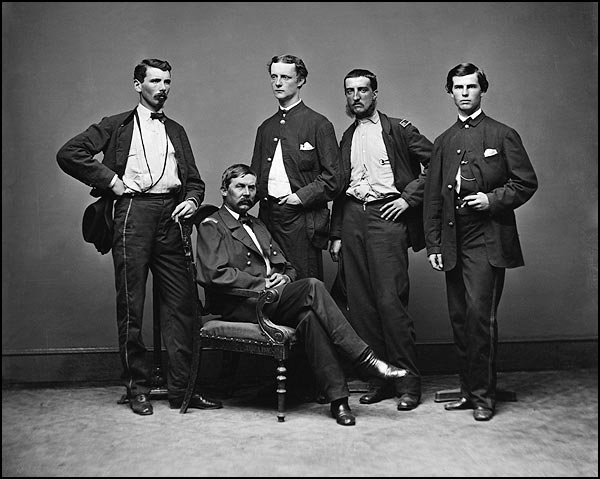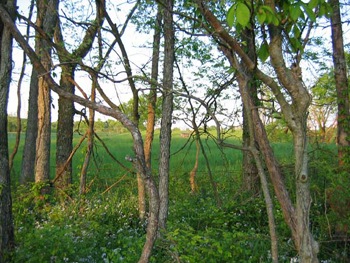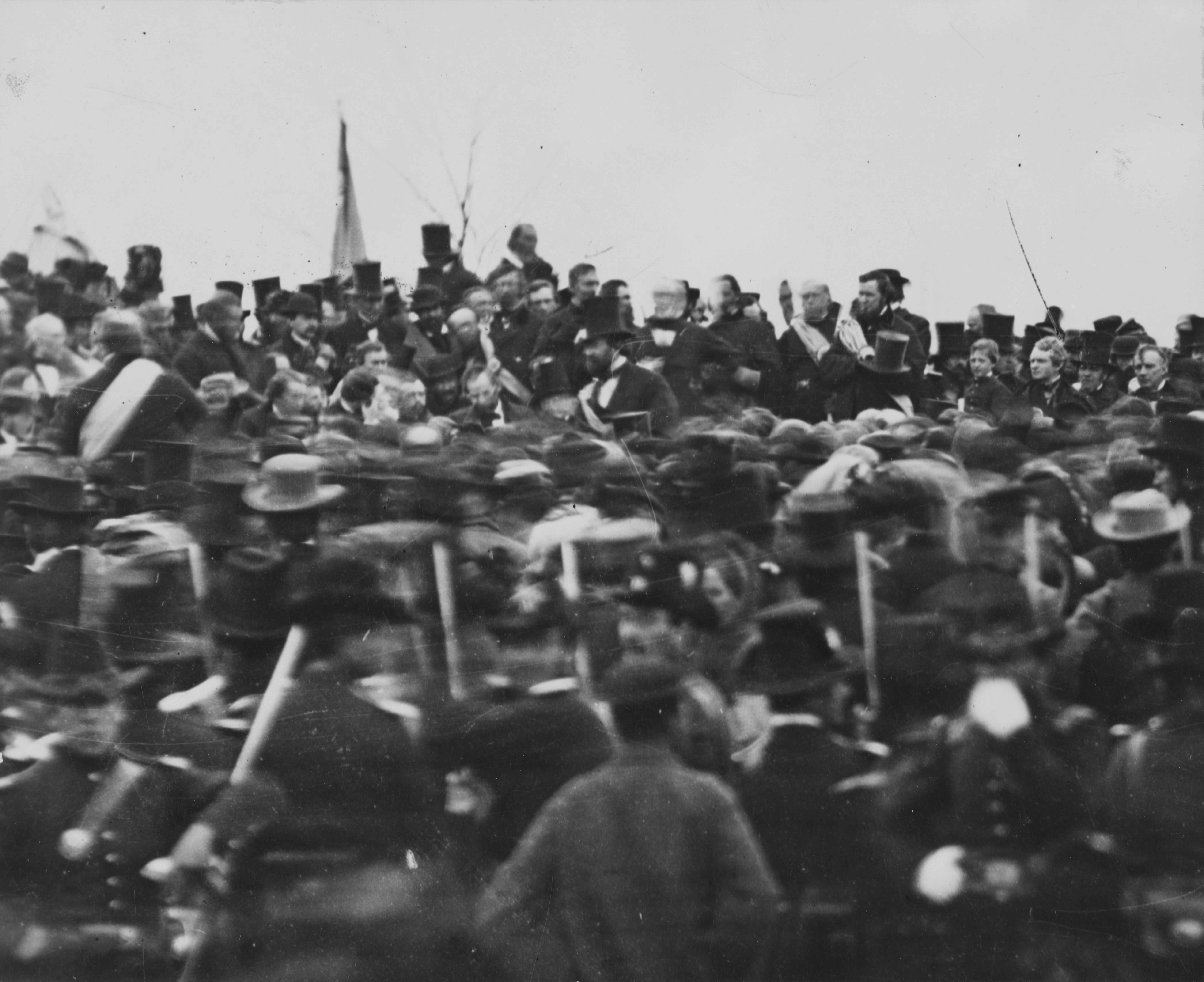|
John Buford
John Buford, Jr. (March 4, 1826 – December 16, 1863) was a United States Army cavalry officer. He fought for the Union as a brigadier general during the American Civil War. Buford is best known for having played a major role in the first day of the Battle of Gettysburg on July 1, 1863, by identifying, taking, and holding the "high ground" while in command of a division. Buford graduated from West Point in 1848. He remained loyal to the United States when the Civil War broke out, despite having been born in the divided border state of Kentucky. During the war he fought against the Confederate Army of Northern Virginia as part of the Army of the Potomac. His first command was a cavalry brigade under Major General John Pope, and he distinguished himself at Second Bull Run in August 1862, where he was wounded, and also saw action at Antietam in September and Stoneman's Raid in spring 1863. Buford's cavalry division played a crucial role in the Gettysburg Campaign that summer. A ... [...More Info...] [...Related Items...] OR: [Wikipedia] [Google] [Baidu] |
Woodford County, Kentucky
Woodford County is a county located in the U.S. state of Kentucky. As of the 2020 census, the population was 26,871. Its county seat is Versailles. The area was home to Pisgah Academy. Woodford County is part of the Lexington-Fayette, KY Metropolitan Statistical Area. It is located in the heart of the Bluegrass region of Kentucky. History The county was formed from a part of Fayette County, Virginia in 1788. It was named for William Woodford, an American Revolutionary War general from Virginia who died while a prisoner of war in 1780. It was the last of the original nine counties established that formed the Commonwealth of Kentucky in 1792. Scott County was formed from part of the county in 1792. Franklin County took another part of the county in 1794. Queen Elizabeth II stayed in Woodford County at Lane's End Farm in May 2007. She also attended the Kentucky Derby in Louisville. Pisgah Academy Pisgah Academy was a school in Woodford County. It was established by Col. Alex ... [...More Info...] [...Related Items...] OR: [Wikipedia] [Google] [Baidu] |
Battle Of Gettysburg
The Battle of Gettysburg () was fought July 1–3, 1863, in and around the town of Gettysburg, Pennsylvania, by Union and Confederate forces during the American Civil War. In the battle, Union Major General George Meade's Army of the Potomac defeated attacks by Confederate General Robert E. Lee's Army of Northern Virginia, halting Lee's invasion of the North. The battle involved the largest number of casualties of the entire war and is often described as the war's turning point due to the Union's decisive victory and concurrence with the Siege of Vicksburg.Rawley, p. 147; Sauers, p. 827; Gallagher, ''Lee and His Army'', p. 83; McPherson, p. 665; Eicher, p. 550. Gallagher and McPherson cite the combination of Gettysburg and Vicksburg as the turning point. Eicher uses the arguably related expression, " High-water mark of the Confederacy". After his success at Chancellorsville in Virginia in May 1863, Lee led his army through the Shenandoah Valley to begin his second ... [...More Info...] [...Related Items...] OR: [Wikipedia] [Google] [Baidu] |
Gettysburg, Pennsylvania
Gettysburg (; non-locally ) is a borough and the county seat of Adams County in the U.S. state of Pennsylvania. The Battle of Gettysburg (1863) and President Abraham Lincoln's Gettysburg Address are named for this town. Gettysburg is home to the Gettysburg National Military Park, where the Battle of Gettysburg was largely fought; the Battle of Gettysburg had the most casualties of any Civil War battle but was also considered the turning point in the war, leading to the Union's ultimate victory. As of the 2020 census, the borough had a population of 7,106 people. History Early history In 1761, Irishman Samuel Gettys settled at the Shippensburg-Baltimore and Philadelphia-Pittsburgh crossroads, in what was then western York County, and established a tavern frequented by soldiers and traders. In 1786, the borough boundary was established, with the Dobbin House tavern (established in 1776) sitting in the southwest. As early as 1790, a movement seeking to split off the western ... [...More Info...] [...Related Items...] OR: [Wikipedia] [Google] [Baidu] |
John Pope (military Officer)
John Pope (March 16, 1822 – September 23, 1892) was a career United States Army officer and Union general in the American Civil War. He had a brief stint in the Western Theater, but he is best known for his defeat at the Second Battle of Bull Run (Second Manassas) in the East. Pope was a graduate of the United States Military Academy in 1842. He served in the Mexican–American War and had numerous assignments as a topographical engineer and surveyor in Florida, New Mexico, and Minnesota. He spent much of the last decade before the Civil War surveying possible southern routes for the proposed First transcontinental railroad. He was an early appointee as a Union brigadier general of volunteers and served initially under Maj. Gen. John C. Frémont. He achieved initial success against Brig. Gen. Sterling Price in Missouri, then led a successful campaign that captured Island No. 10 on the Mississippi River. This inspired the Lincoln administration to bring him to the Eastern Thea ... [...More Info...] [...Related Items...] OR: [Wikipedia] [Google] [Baidu] |
Army Of Northern Virginia
The Army of Northern Virginia was the primary military force of the Confederate States of America in the Eastern Theater of the American Civil War. It was also the primary command structure of the Department of Northern Virginia. It was most often arrayed against the Union Army of the Potomac. Origin The name ''Army of Northern Virginia'' referred to its primary area of operation, as did most Confederate States Army names. The Army originated as the Army of the Potomac, which was organized on June 20, 1861, from all operational forces in northern Virginia. On July 20 and July 21, the Army of the Shenandoah and forces from the District of Harpers Ferry were added. Units from the Army of the Northwest were merged into the Army of the Potomac between March 14 and May 17, 1862. The Army of the Potomac was renamed ''Army of Northern Virginia'' on March 14. The Army of the Peninsula was merged into it on April 12, 1862.Eicher, pp. 889–90. Robert E. Lee's biographer, Douglas S. ... [...More Info...] [...Related Items...] OR: [Wikipedia] [Google] [Baidu] |
Confederate Army
The Confederate States Army, also called the Confederate Army or the Southern Army, was the military land force of the Confederate States of America (commonly referred to as the Confederacy) during the American Civil War (1861–1865), fighting against the United States forces to win the independence of the Southern states and uphold the institution of slavery. On February 28, 1861, the Provisional Confederate Congress established a provisional volunteer army and gave control over military operations and authority for mustering state forces and volunteers to the newly chosen Confederate president, Jefferson Davis. Davis was a graduate of the U.S. Military Academy, and colonel of a volunteer regiment during the Mexican–American War. He had also been a United States senator from Mississippi and U.S. Secretary of War under President Franklin Pierce. On March 1, 1861, on behalf of the Confederate government, Davis assumed control of the military situation at Charleston, South ... [...More Info...] [...Related Items...] OR: [Wikipedia] [Google] [Baidu] |
Cavalry
Historically, cavalry (from the French word ''cavalerie'', itself derived from "cheval" meaning "horse") are soldiers or warriors who fight mounted on horseback. Cavalry were the most mobile of the combat arms, operating as light cavalry in the roles of reconnaissance, screening, and skirmishing in many armies, or as heavy cavalry for decisive shock attacks in other armies. An individual soldier in the cavalry is known by a number of designations depending on era and tactics, such as cavalryman, horseman, trooper, cataphract, knight, hussar, uhlan, mamluk, cuirassier, lancer, dragoon, or horse archer. The designation of ''cavalry'' was not usually given to any military forces that used other animals for mounts, such as camels or elephants. Infantry who moved on horseback, but dismounted to fight on foot, were known in the early 17th to the early 18th century as '' dragoons'', a class of mounted infantry which in most armies later evolved into standard cavalry while ... [...More Info...] [...Related Items...] OR: [Wikipedia] [Google] [Baidu] |
Napoleon Bonaparte Buford
Napoleon Bonaparte Buford (January 13, 1807 – March 28, 1883) was an American soldier, Union general in the American Civil War, and railroad executive. He was the half-brother of the famous Gettysburg hero, John Buford, but never attained his sibling's military distinction. Early life and education Buford was the son of John and Nancy Hickman Buford. He was born in Woodford County, Kentucky on his family's plantation, "Rose Hill." At the time of his birth his namesake, Napoleon Bonaparte, Emperor of the French, was at the height of his power. Buford graduated from West Point in 1827 and served for eight years in the artillery and in 1835 resigned from the service to become an engineer. He thereafter engaged in iron manufacturing and banking at Rock Island, Illinois and became president of the Rock Island and Peoria Railroad, which went bankrupt when major Southern bonds were defaulted with the start of the Civil War. Career In the U.S. Civil War, he first served as colonel o ... [...More Info...] [...Related Items...] OR: [Wikipedia] [Google] [Baidu] |





